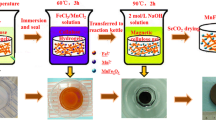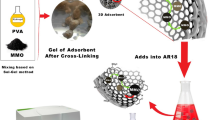Abstract
The pore structure of the regenerated cellulose hydrogel was used as a microreactor for generating magnetic MnFe2O4 nanoparticles via in situ co-precipitation technology. Sodium periodate and sodium chlorite were used as oxidants, and the carboxyl modification of magnetic cellulose aerogels was achieved through a two-step oxidation reaction. The method used was convenient and environmental-friendly, and the raw materials were also green and non-toxic. The addition of magnetic nanoparticles promoted the adsorption and enabled the recycling of materials. The results showed that the adsorption equilibrium time was only 120 min and adsorption capacity could be increased by increasing the adsorption temperature. The maximum adsorption capacity of Cu(II) was 73.70 mg/g at 25 °C when the initial concentration of solution was150 mg/L. The adsorption behaviour towards Cu(II) followed the pseudo-secondary reaction kinetics and the Langmuir isotherm adsorption model. According to the results of XPS, carboxyl and hydroxyl groups were the main active adsorption sites for Cu(II). Moreover, all the composite aerogels exhibited good reusability and could be easily separated from the water after adsorption.
Graphical abstract
The pore structure of the regenerated cellulose hydrogel was used as a microreactor for generating magnetic MnFe2O4 nanoparticles via in situ co-precipitation technology. Sodium periodate and sodium chlorite were used as oxidants, and the carboxyl modification of magnetic cellulose aerogels was achieved through a two-step oxidation reaction. According to the results of XPS, carboxyl and hydroxyl groups were the main adsorption sites for Cu(II). Moreover, all the composite aerogels exhibited good reusability and could be easily separated from the water after adsorption.













Similar content being viewed by others
References
Ali I (2012) New generation adsorbents for water treatment. Chem Rev 112:5073–5091. https://doi.org/10.1021/cr300133d
Bo SG et al (2018) Flexible and porous cellulose aerogels/zeolitic imidazolate framework (ZIF-8) hybrids for adsorption removal of Cr(IV) from water. J Solid State Chem 262:135–141. https://doi.org/10.1016/j.jssc.2018.02.022
Bratskaya SY, Azarova YA, Matochkina EG, Kodess MI, Yatluk YG, Pestov AV (2012) N-(2-(2-pyridyl)ethyl)chitosan: synthesis, characterization and sorption properties. Carbohydr Polym 87:869–875. https://doi.org/10.1016/j.carbpol.2011.08.081
Corsi I, Fiorati A, Grassi G, Bartolozzi I, Daddi T, Melone L, Punta C (2018) Environmentally sustainable and ecosafe polysaccharide-based materials for water nano-treatment: an eco-design study. Materials (Basel). https://doi.org/10.3390/ma11071228
Cui S et al (2017) Preparation of magnetic MnFe2O4–Cellulose aerogel composite and its kinetics and thermodynamics of Cu(II) adsorption. Cellulose 25:735–751. https://doi.org/10.1007/s10570-017-1598-x
Elwakeelab KZ, El-Bindaryc AA, Koutac EY, Guibald E (2018) Functionalization of polyacrylonitrile/Na–Y–zeolite composite with amidoxime groups for the sorption of Cu(II), Cd(II) and Pb(II) metal ions. Chem Eng J 332:727–736. https://doi.org/10.1016/j.cej.2017.09.091
Feng J, Nguyen ST, Fan Z, Duong HM (2015) Advanced fabrication and oil absorption properties of super-hydrophobic recycled cellulose aerogels. Chem Eng J 270:168–175. https://doi.org/10.1016/j.cej.2015.02.034
Fu F, Wang Q (2011) Removal of heavy metal ions from wastewaters: a review. J Environ Manag 92:407–418. https://doi.org/10.1016/j.jenvman.2010.11.011
García-González CA, Alnaief M, Smirnova I (2011) Polysaccharide-based aerogels—promising biodegradable carriers for drug delivery systems. Carbohydr Polym 86:1425–1438. https://doi.org/10.1016/j.carbpol.2011.06.066
Hirota M, Tamura N, Saito T, Isogai A (2009) Surface carboxylation of porous regenerated cellulose beads by 4-acetamide-TEMPO/NaClO/NaClO2 system. Cellulose 16:841–851. https://doi.org/10.1007/s10570-009-9296-y
Kettunen M et al (2011) Photoswitchable superabsorbency based on nanocellulose aerogels. Adv Func Mater 21:510–517. https://doi.org/10.1002/adfm.201001431
Kharissova OV, Dias HVR, Kharisov BI (2015) Magnetic adsorbents based on micro- and nano-structured materials. RSC Adv 5:6695–6719. https://doi.org/10.1039/c4ra11423j
Kim UJ, Kim D, You J, Choi JW, Kimura S, Wada M (2018) Preparation of cellulose–chitosan foams using an aqueous lithium bromide solution and their adsorption ability for Congo red. Cellulose 25:2615–2628. https://doi.org/10.1007/s10570-018-1742-2
Li A et al (2016) An environment-friendly and multi-functional absorbent from chitosan for organic pollutants and heavy metal ion. Carbohydr Polym 148:272–280. https://doi.org/10.1016/j.carbpol.2016.04.070
Li J, Zheng L, Liu H (2017) A novel carbon aerogel prepared for adsorption of copper(II) ion in water. J Porous Mater 24:1575–1580. https://doi.org/10.1007/s10934-017-0397-y
Li J et al (2018a) Shape memory aerogels from nanocellulose and polyethyleneimine as a novel adsorbent for removal of Cu(II) and Pb(II). Carbohydr Polym 196:376–384. https://doi.org/10.1016/j.carbpol.2018.05.015
Li Z et al (2018b) Converting untreated waste office paper and chitosan into aerogel adsorbent for the removal of heavy metal ions. Carbohydr Polym 193:221–227. https://doi.org/10.1016/j.carbpol.2018.04.003
Liu P, Oksman K, Mathew AP (2016) Surface adsorption and self-assembly of Cu(II) ions on TEMPO-oxidized cellulose nanofibers in aqueous media. J Colloid Interface Sci 464:175–182. https://doi.org/10.1016/j.jcis.2015.11.033
Luo X, Zeng J, Liu S, Zhang L (2015) An effective and recyclable adsorbent for the removal of heavy metal ions from aqueous system: magnetic chitosan/cellulose microspheres. Bioresour Technol 194:403–406. https://doi.org/10.1016/j.biortech.2015.07.044
Ma HQ, Wang SJ, Meng FB, Xu XY, Huo XL (2017) A hydrazone-carboxyl ligand-linked cellulose nanocrystal aerogel with high elasticity and fast oil/water separation. Cellulose 24:797–809. https://doi.org/10.1007/s10570-016-1132-6
Maatar W, Boufi S (2017) Microporous cationic nanofibrillar cellulose aerogel as promising adsorbent of acid dyes. Cellulose 24:1001–1015. https://doi.org/10.1007/s10570-016-1162-0
Martin WJ II, Glass Rl, Balbus JM, Collins FS (2011) A major environmental cause of death. Science 334:180–181. https://doi.org/10.1126/science.1213088
Musso TB, Parolo ME, Pettinari G, Francisca FM (2014) Cu(II) and Zn(II) adsorption capacity of three different clay liner materials. J Environ Manag 146:50–58. https://doi.org/10.1016/j.jenvman.2014.07.026
Nagajyoti PC, Lee KD, Sreekanth TVM (2010) Heavy metals, occurrence and toxicity for plants: a review. Environ Chem Lett 8:199–216. https://doi.org/10.1007/s10311-010-0297-8
Olsson RT et al (2010) Making flexible magnetic aerogels and stiff magnetic nanopaper using cellulose nanofibrils as templates. Nat Nanotechnol 5:584. https://doi.org/10.1038/nnano.2010.155
Ren Y, Li N, Feng J, Luan T, Wen Q, Li Z, Zhang M (2012) Adsorption of Pb(II) and Cu(II) from aqueous solution on magnetic porous ferrospinel MnFe2O4. J Colloid Interface Sci 367:415–421. https://doi.org/10.1016/j.jcis.2011.10.022
Ren F, Li Z, Tan WZ, Liu XH, Sun ZF, Ren PG, Yan DX (2018) Facile preparation of 3D regenerated cellulose/graphene oxide composite aerogel with high-efficiency adsorption towards methylene blue. J Colloid Interface Sci 532:58–67. https://doi.org/10.1016/j.jcis.2018.07.101
Rong LD et al (2018) Facile fabrication of thiol-modified cellulose sponges for adsorption of Hg2+from aqueous solutions. Cellulose 25:3025–3035. https://doi.org/10.1007/s10570-018-1758-7
Sharifpour E, Khafri HZ, Ghaedi M, Asfaram A, Jannesar R (2018) Isotherms and kinetic study of ultrasound-assisted adsorption of malachite green and Pb(2+) ions from aqueous samples by copper sulfide nanorods loaded on activated carbon: experimental design optimization. Ultrason Sonochem 40:373–382. https://doi.org/10.1016/j.ultsonch.2017.07.030
Shi J, Lu L, Guo W, Sun Y, Cao Y (2013) An environment–friendly thermal insulation material from cellulose and plasma modification. Appl Polym. https://doi.org/10.1002/app.39615
Singh D, Verma S, Gautam RK, Krishna V (2015) Copper adsorption onto synthesized nitrilotriacetic acid functionalized Fe3O4 nanoparticles: kinetic, equilibrium and thermodynamic studies. J Environ Chem Eng 3:2161–2171. https://doi.org/10.1016/j.jece.2015.07.020
Štandeker S, Veronovski A, Novak Z, Knez Ž (2011) Silica aerogels modified with mercapto functional groups used for Cu(II) and Hg(II) removal from aqueous solutions. Desalination 269:223–230. https://doi.org/10.1016/j.desal.2010.10.064
Stefelova J, Slovak V, Siqueira G, Olsson RT, Tingaut P, Zimmermann T, Sehaqui H (2017) Drying and pyrolysis of cellulose nanofibers from wood, bacteria, and algae for char application in oil absorption and dye adsorption. ACS Sustain Chem Eng 5:2679–2692. https://doi.org/10.1021/acssuschemeng.6b03027
Wang DC, Yu HY, Song ML, Yang RT, Yao JM (2017) Superfast adsorption-disinfection cryogels decorated with cellulose nanocrystal/zinc oxide nanorod clusters for water purifying microdevices. ACS Sustain Chem Eng 5:6776–6785. https://doi.org/10.1021/acssuschemeng.7b01029
Xiao M, Hu J (2017) Cellulose/chitosan composites prepared in ethylene diamine/potassium thiocyanate for adsorption of heavy metal ions. Cellulose 24:2545–2557. https://doi.org/10.1007/s10570-017-1287-9
Yang J, Xia YF, Xu P, Chen BB (2018) Super-elastic and highly hydrophobic/superoleophilic sodium alginate/cellulose aerogel for oil/water separation. Cellulose 25:3533–3544. https://doi.org/10.1007/s10570-018-1801-8
Yuan DS, Zhang T, Guo Q, Qiu FX, Yang DY, Ou ZP (2018) Recyclable biomass carbon@SiO2@MnO2 aerogel with hierarchical structures for fast and selective oil–water separation. Chem Eng J 351:622–630. https://doi.org/10.1016/j.cej.2018.06.132
Zhang J, Fu H, Lv X, Tang J, Xu X (2011) Removal of Cu(II) from aqueous solution using the rice husk carbons prepared by the physical activation process. Biomass Bioenergy 35:464–472. https://doi.org/10.1016/j.biombioe.2010.09.002
Zheng Q, Cai Z, Gong S (2014) Green synthesis of polyvinyl alcohol (PVA)–cellulose nanofibril (CNF) hybrid aerogels and their use as superabsorbents. J Mater Chem A 2:3110–3118. https://doi.org/10.1039/c3ta14642a
Zhu HX, Cao XJ, He YC, Kong QP, He H, Wang J (2015) Removal of Cu(2)(+) from aqueous solutions by the novel modified bagasse pulp cellulose: kinetics, isotherm and mechanism. Carbohydr Polym 129:115–126. https://doi.org/10.1016/j.carbpol.2015.04.049
Acknowledgments
This work was financially supported by the Major Program of Natural Science Fund in Colleges and Universities of Jiangsu Province (15KJA430005), Key Research and Development(Industry Prospect and Common Key Technology) Project of Jiangsu Province (BE2016171, BE2017151), the Program for Changjiang Scholars and Innovative Research Team in University (No.IRT_15R35), the Postgraduate Research&Practice Innovation Program of Jiangsu Province and the Priority Academic Program Development of Jiangsu Higher Education Institutions. Any opinions, findings, and conclusions or recommendations expressed in this paper are those of the authors and do not necessarily reflect the views of these programmes.
Author information
Authors and Affiliations
Corresponding author
Additional information
Publisher's Note
Springer Nature remains neutral with regard to jurisdictional claims in published maps and institutional affiliations.
Rights and permissions
About this article
Cite this article
Wang, X., Jiang, S., Cui, S. et al. Magnetic-controlled aerogels from carboxylated cellulose and MnFe2O4 as a novel adsorbent for removal of Cu(II). Cellulose 26, 5051–5063 (2019). https://doi.org/10.1007/s10570-019-02444-7
Received:
Accepted:
Published:
Issue Date:
DOI: https://doi.org/10.1007/s10570-019-02444-7




